Astronomers Have Just Assembled One Of The Most Comprehensive Portraits Yet Of The Universe’s Evolutionary
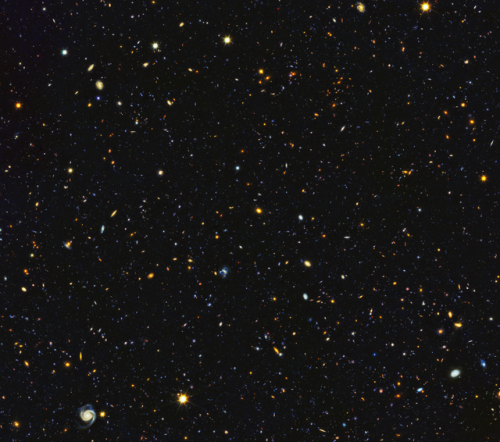
Astronomers have just assembled one of the most comprehensive portraits yet of the universe’s evolutionary history, based on a broad spectrum of observations by the Hubble Space Telescope and other space and ground-based telescopes. In particular, Hubble’s ultraviolet vision opens a new window on the evolving universe, tracking the birth of stars over the last 11 billion years back to the cosmos’ busiest star-forming period, about 3 billion years after the big bang. This photo encompasses a sea of approximately 15,000 galaxies — 12,000 of which are star-forming — widely distributed in time and space. This mosaic is 14 times the area of the Hubble Ultra Violet Ultra Deep Field released in 2014.
Credits: NASA, ESA, P. Oesch (University of Geneva), and M. Montes (University of New South Wales)
More Posts from Ocrim1967 and Others





Study Tips Based on Your Hogwarts House
Just finished rewatching all 8 of the Harry Potter films last week… and I thought why not make my first graphic related to it? So, here’s study tips for each of the Hogwarts houses! I know some of these doesn’t apply to everyone, but I had really fun time making this :) Hope this helps!
What is an Exoplanet?
An exoplanet or extrasolar planet is a planet outside our solar system that orbits a star. The first evidence of an exoplanet was noted as early as 1917, but was not recognized as such. However, the first scientific detection of an exoplanet was in 1988. Shortly afterwards, the first confirmed detection was in 1992. As of 1 April 2018, there are 3,758 confirmed planets in 2,808 systems, with 627 systems having more than one planet.

The High Accuracy Radial Velocity Planet Searcher (HARPS, since 2004) has discovered about a hundred exoplanets while the Kepler space telescope (since 2009) has found more than two thousand. Kepler has also detected a few thousand candidate planets, of which about 11% may be false positives.

In several cases, multiple planets have been observed around a star. About 1 in 5 Sun-like stars have an “Earth-sized” planet in the habitable zone. Assuming there are 200 billion stars in the Milky Way, one can hypothesize that there are 11 billion potentially habitable Earth-sized planets in the Milky Way, rising to 40 billion if planets orbiting the numerous red dwarfs are included.

The least massive planet known is Draugr (also known as PSR B1257+12 A or PSR B1257+12 b), which is about twice the mass of the Moon. The most massive planet listed on the NASA Exoplanet Archive is HR 2562 b, about 30 times the mass of Jupiter, although according to some definitions of a planet, it is too massive to be a planet and may be a brown dwarf instead.

There are planets that are so near to their star that they take only a few hours to orbit and there are others so far away that they take thousands of years to orbit.

Some are so far out that it is difficult to tell whether they are gravitationally bound to the star. Almost all of the planets detected so far are within the Milky Way. Nonetheless, evidence suggests that extragalactic planets, exoplanets further away in galaxies beyond the local Milky Way galaxy, may exist. The nearest exoplanet is Proxima Centauri b, located 4.2 light-years (1.3 parsecs) from Earth and orbiting Proxima Centauri, the closest star to the Sun.

Besides exoplanets, there are also rogue planets, which do not orbit any star and which tend to be considered separately, especially if they are gas giants, in which case they are often counted, like WISE 0855−0714, as sub-brown dwarfs. The rogue planets in the Milky Way possibly number in the billions (or more).

Some planets orbit one member of a binary star system, and several circumbinary planets have been discovered which orbit around both members of binary star. A few planets in triple star systems are known and one in the quadruple system Kepler-64.

Methods of detecting exoplanets
1° Radial velocity
A star with a planet will move in its own small orbit in response to the planet’s gravity. This leads to variations in the speed with which the star moves toward or away from Earth, i.e. the variations are in the radial velocity of the star with respect to Earth. The radial velocity can be deduced from the displacement in the parent star’s spectral lines due to the Doppler effect. The radial-velocity method measures these variations in order to confirm the presence of the planet using the binary mass function.

2º Transit photometry
While the radial velocity method provides information about a planet’s mass, the photometric method can determine the planet’s radius. If a planet crosses (transits) in front of its parent star’s disk, then the observed visual brightness of the star drops by a small amount; depending on the relative sizes of the star and the planet.

3° Direct Imaging
Exoplanets are far away, and they are millions of times dimmer than the stars they orbit. So, unsurprisingly, taking pictures of them the same way you’d take pictures of, say Jupiter or Venus, is exceedingly hard.
New techniques and rapidly-advancing technology are making it happen.
The major problem astronomers face in trying to directly image exoplanets is that the stars they orbit are millions of times brighter than their planets. Any light reflected off of the planet or heat radiation from the planet itself is drowned out by the massive amounts of radiation coming from its host star. It’s like trying to find a flea in a lightbulb, or a firefly flitting around a spotlight.

On a bright day, you might use a pair of sunglasses, or a car’s sun visor, or maybe just your hand to block the glare of the sun so that you can see other things.
This is the same principle behind the instruments designed to directly image exoplanets. They use various techniques to block out the light of stars that might have planets orbiting them. Once the glare of the star is reduced, they can get a better look at objects around the star that might be exoplanets.
4° Gravitational Microlensing
Gravitational microlensing occurs when the gravitational field of a star acts like a lens, magnifying the light of a distant background star. This effect occurs only when the two stars are almost exactly aligned. Lensing events are brief, lasting for weeks or days, as the two stars and Earth are all moving relative to each other. More than a thousand such events have been observed over the past ten years.

If the foreground lensing star has a planet, then that planet’s own gravitational field can make a detectable contribution to the lensing effect. Since that requires a highly improbable alignment, a very large number of distant stars must be continuously monitored in order to detect planetary microlensing contributions at a reasonable rate. This method is most fruitful for planets between Earth and the center of the galaxy, as the galactic center provides a large number of background stars.
5° Astrometry
This method consists of precisely measuring a star’s position in the sky, and observing how that position changes over time. Originally, this was done visually, with hand-written records. By the end of the 19th century, this method used photographic plates, greatly improving the accuracy of the measurements as well as creating a data archive. If a star has a planet, then the gravitational influence of the planet will cause the star itself to move in a tiny circular or elliptical orbit.

Effectively, star and planet each orbit around their mutual centre of mass (barycenter), as explained by solutions to the two-body problem. Since the star is much more massive, its orbit will be much smaller. Frequently, the mutual centre of mass will lie within the radius of the larger body. Consequently, it is easier to find planets around low-mass stars, especially brown dwarfs.
source
source (+ Methods of detecting exoplanets)
source
images: NASA/ESA, ESO
animations: x, x, x, x, x
+ Exoplanets
Some intriguing exoplanets
3 Ways To Eliminate eLearning Friction With Mobile Learning And Microlearning

“In a world that grows increasingly more mobile, it’s important to embrace mobile technology and microlearning to eliminate eLearning friction caused by distracted learners and a poor learning experience.”
What is a Wormhole?
Wormholes were first theorized in 1916, though that wasn’t what they were called at the time. While reviewing another physicist’s solution to the equations in Albert Einstein’s theory of general relativity, Austrian physicist Ludwig Flamm realized another solution was possible. He described a “white hole,” a theoretical time reversal of a black hole. Entrances to both black and white holes could be connected by a space-time conduit.

In 1935, Einstein and physicist Nathan Rosen used the theory of general relativity to elaborate on the idea, proposing the existence of “bridges” through space-time. These bridges connect two different points in space-time, theoretically creating a shortcut that could reduce travel time and distance. The shortcuts came to be called Einstein-Rosen bridges, or wormholes.

Certain solutions of general relativity allow for the existence of wormholes where the mouth of each is a black hole. However, a naturally occurring black hole, formed by the collapse of a dying star, does not by itself create a wormhole.
Wormholes are consistent with the general theory of relativity, but whether wormholes actually exist remains to be seen.

A wormhole could connect extremely long distances such as a billion light years or more, short distances such as a few meters, different universes, or different points in time
For a simplified notion of a wormhole, space can be visualized as a two-dimensional (2D) surface. In this case, a wormhole would appear as a hole in that surface, lead into a 3D tube (the inside surface of a cylinder), then re-emerge at another location on the 2D surface with a hole similar to the entrance. An actual wormhole would be analogous to this, but with the spatial dimensions raised by one. For example, instead of circular holes on a 2D plane, the entry and exit points could be visualized as spheres in 3D space.

Science fiction is filled with tales of traveling through wormholes. But the reality of such travel is more complicated, and not just because we’ve yet to spot one.

The first problem is size. Primordial wormholes are predicted to exist on microscopic levels, about 10–33 centimeters. However, as the universe expands, it is possible that some may have been stretched to larger sizes.
Another problem comes from stability. The predicted Einstein-Rosen wormholes would be useless for travel because they collapse quickly.

“You would need some very exotic type of matter in order to stabilize a wormhole,” said Hsu, “and it’s not clear whether such matter exists in the universe.”
But more recent research found that a wormhole containing “exotic” matter could stay open and unchanging for longer periods of time.

Exotic matter, which should not be confused with dark matter or antimatter, contains negative energy density and a large negative pressure. Such matter has only been seen in the behavior of certain vacuum states as part of quantum field theory.
If a wormhole contained sufficient exotic matter, whether naturally occurring or artificially added, it could theoretically be used as a method of sending information or travelers through space. Unfortunately, human journeys through the space tunnels may be challenging.

Wormholes may not only connect two separate regions within the universe, they could also connect two different universes. Similarly, some scientists have conjectured that if one mouth of a wormhole is moved in a specific manner, it could allow for time travel.

Although adding exotic matter to a wormhole might stabilize it to the point that human passengers could travel safely through it, there is still the possibility that the addition of “regular” matter would be sufficient to destabilize the portal.
Today’s technology is insufficient to enlarge or stabilize wormholes, even if they could be found. However, scientists continue to explore the concept as a method of space travel with the hope that technology will eventually be able to utilize them.
source
source
images: x, x, x, x, x, x, x, x, x
Hilarious Animal Snapchats That Are Impossible Not To Laugh At
























Couple goals



Happy Birthday, Albert Einstein! Genius Scientist Turns 140 Years Old Today.
The year 1905 came to be known as Einstein’s Miracle Year. He was 26 years old, and in that year he published four papers that reshaped physics.
Photoelectric effect
The first explained what’s called the photoelectric effect – one of the bases for modern-day electronics – with practical applications including television. His paper on the photoelectric effect helped pave the way for quantum mechanics by establishing that light is both a particle and a wave. For this work, Einstein was later awarded a Nobel Prize in physics.


Brownian motion
Another 1905 paper related to Brownian motion. In it, Einstein stated that the seemingly random motion of particles in a fluid (Brownian motion) was a predictable, measurable part of the movement of atoms and molecules. This helped establish the Kinetic Molecular Theory of Heat, which says that, if you heat something, its molecules begin to vibrate. At this same time, Einstein provided definitive confirmation that atoms and molecules actually exist.


Special relativity
Also in 1905, Einstein published his Special Theory of Relativity. Before it, space, time and mass all seemed to be absolutes – the same for everyone. Einstein showed that different people perceive mass, space and time differently, but that these effects don’t show up until you start moving nearly at the speed of light. Then you find, for example, that time on a swiftly moving spaceship slows down, while the mass of the ship increases. According to Einstein, a spaceship traveling at the speed of light would have infinite mass, and a body of infinite mass also has infinite resistance to motion. And that’s why nothing can accelerate to a speed faster than light speed. Because of Einstein’s special relativity, light is now seen as an absolute in a universe of shifting values for space, time and matter.

Mass-energy equivalence
The fourth 1905 paper stated that mass and energy are equivalent. You perhaps know something of this work in Einstein’s famous equation E=mc2. That equation means that energy (E) is equal to mass (m) multiplied by the speed of light © squared. Sound simple? It is, in a way. It means that matter and energy are the same thing. It’s also very profound, in part because the speed of light is a huge number. As shown by the equation, a small amount of mass can be converted into a large amount of energy … as in atomic bombs. It’s this same conversion of mass to energy, by the way, that causes stars to shine.
But Einstein didn’t stop there. As early as 1911, he’d predicted that light passing near a large mass, such as a star, would be bent. That idea led to his General Theory of Relativity in 1916.


This paper established the modern theory of gravitation and gave us the notion of curved space. Einstein showed, for example, that small masses such as planets form dimples in space-time that hardly affect the path of starlight. But big masses such as stars produce measurably curved space.





The fact that the curved space around our sun was measurable let other scientists prove Einstein’s theory. In 1919, two expeditions organized by Arthur Eddington photographed stars near the sun made visible during a solar eclipse. The displacement of these stars with respect to their true positions on the celestial sphere showed that the sun’s gravity does cause space to curve so that starlight traveling near the sun is bent from its original path. This observation confirmed Einstein’s theory, and made Einstein a household name.
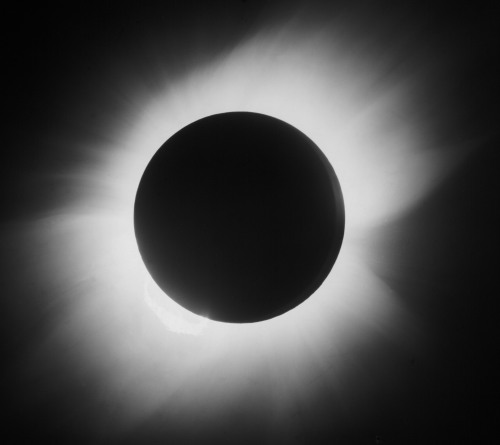
Source (read more) posts about Einstein

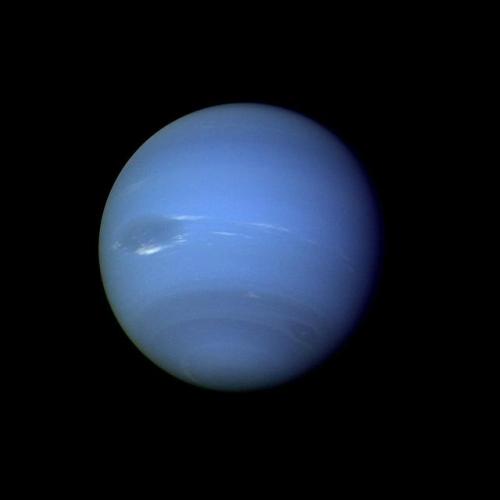
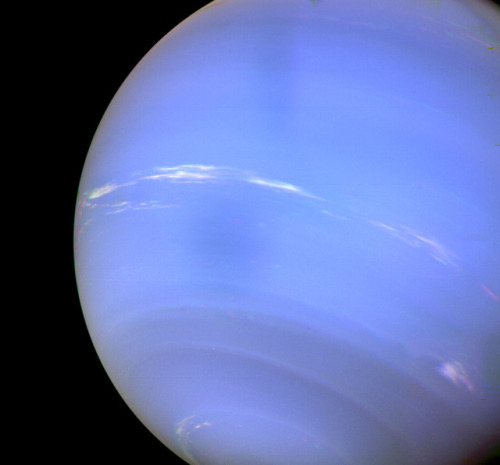
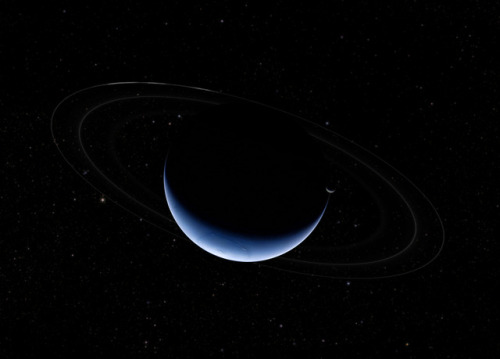
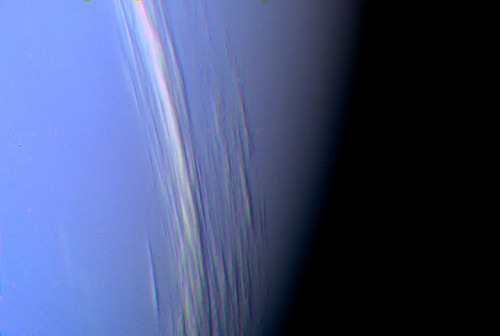
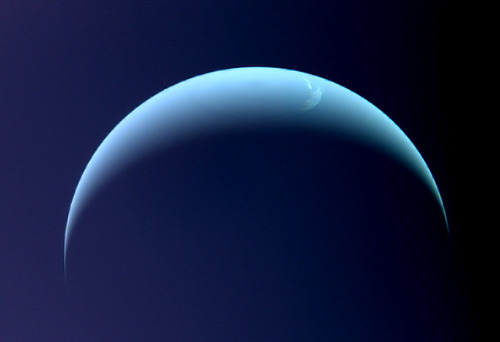
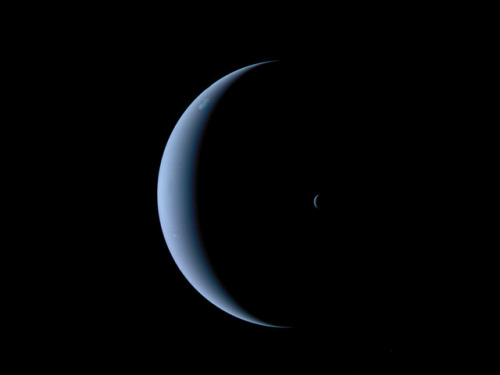
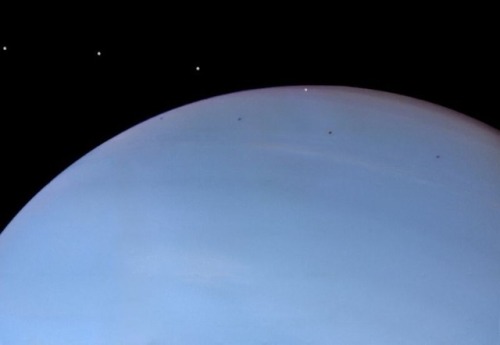
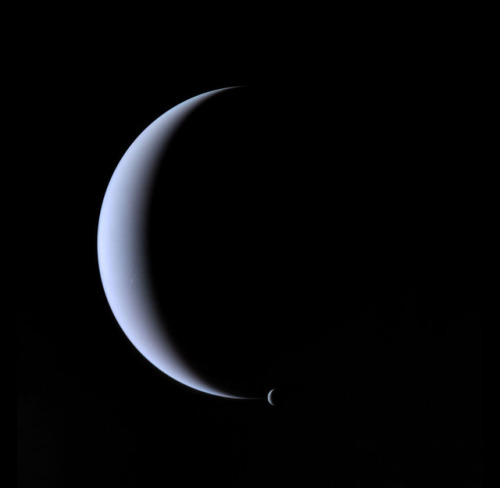
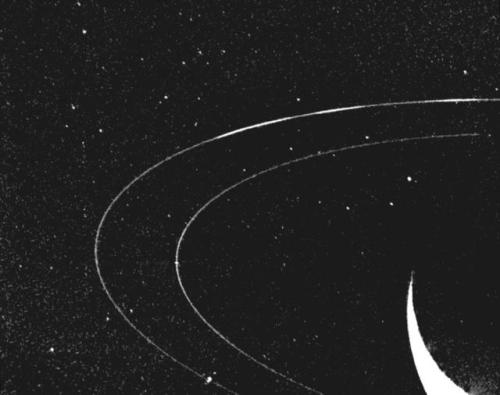
Neptune ♆
On this day in 1846 was discovered the planet Neptune.
The ice giant Neptune was the first planet located through mathematical predictions rather than through regular observations of the sky. (Galileo had recorded it as a fixed star during observations with his small telescope in 1612 and 1613.) When Uranus didn’t travel exactly as astronomers expected it to, a French mathematician, Urbain Joseph Le Verrier, proposed the position and mass of another as yet unknown planet that could cause the observed changes to Uranus’ orbit. After being ignored by French astronomers, Le Verrier sent his predictions to Johann Gottfried Galle at the Berlin Observatory, who found Neptune on his first night of searching in 1846. Seventeen days later, its largest moon, Triton, was also discovered.
Neptune is invisible to the naked eye because of its extreme distance from Earth. Interestingly, the highly eccentric orbit of the dwarf planet Pluto brings Pluto inside Neptune’s orbit for a 20-year period out of every 248 Earth years. Pluto can never crash into Neptune, though, because for every three laps Neptune takes around the Sun, Pluto makes two. This repeating pattern prevents close approaches of the two bodies.
Nearly 4.5 billion kilometers (2.8 billion miles) from the Sun, Neptune orbits the Sun once every 165 years.
Uranus’ blue-green color is also the result of atmospheric methane, but Neptune is a more vivid, brighter blue, so there must be an unknown component that causes the more intense color.
Despite its great distance and low energy input from the Sun, Neptune’s winds can be three times stronger than Jupiter’s and nine times stronger than Earth’s.
Winds on Neptune travel faster than the speed of sound.
In 1989, Voyager 2 tracked a large, oval-shaped, dark storm in Neptune’s southern hemisphere. This “Great Dark Spot” was large enough to contain the entire Earth.
Neptune has five known rings. Voyager 2’s observations confirmed that these unusual rings are not uniform but have four thick regions (clumps of dust) called arcs. The rings are thought to be relatively young and short-lived.
Neptune has 14 known moons, six of which were discovered by Voyager 2.
Triton, Neptune’s largest moon, orbits the planet in the opposite direction compared with the rest of the moons, suggesting that it may have been captured by Neptune in the distant past.
To know more about the planet Neptune click here and here.
Images credit: NASA/JPL- Caltech (some images processed by Kevin M. Gill)
Parker Solar Probe is Go for Launch
Tomorrow, Aug. 11, we’re launching a spacecraft to touch the Sun.

The first chance to launch Parker Solar Probe is 3:33 a.m. EDT on Aug. 11 from Space Launch Complex 37 at Cape Canaveral Air Force Station in Florida. Launch coverage on NASA TV starts at 3 a.m. EDT at nasa.gov/live.
After launch, Parker Solar Probe begins its daring journey to the Sun’s atmosphere, or corona, going closer to the Sun than any spacecraft in history and facing brutal heat and radiation.
Though Parker Solar Probe weighs a mere 1,400 pounds — pretty light for a spacecraft — it’s launching aboard one of the world’s most powerful rockets, a United Launch Alliance Delta IV Heavy with a third stage added.

Even though you might think the Sun’s massive means things would just fall into it, it’s surprisingly difficult to actually go there. Any object leaving Earth starts off traveling at about 67,000 miles per hour, same as Earth — and most of that is in a sideways direction, so you have to shed most of that sideways speed to make it to the Sun. All that means that it takes 55 times more launch energy to go to the Sun than it does to go to Mars. On top of its powerful launch vehicle, Parker Solar Probe will use seven Venus gravity assists to shed sideways speed.
Even though Parker Solar Probe will lose a lot of sideways speed, it’ll still be going incredibly fast as its orbit draws closer to the Sun throughout its seven-year mission. At its fastest, Parker Solar Probe will travel at 430,000 miles per hour — fast enough to get from Philadelphia to Washington, D.C. in one second — setting the record for the fastest spacecraft in history.

But the real challenge was to keep the spacecraft from frying once it got there.
We’ve always wanted to send a mission to the corona, but we literally haven’t had the technology that can protect a spacecraft and its instruments from its scorching heat. Only recent advances have enabled engineers to build a heat shield that will protect the spacecraft on this journey of extremes — a tricky feat that requires withstanding the Sun’s intense radiation on the front and staying cool at the back, so the spacecraft and instruments can work properly.

The 4.5-inches-thick heat shield is built like a sandwich. There’s a thin layer of carbon material like you might find in your golf clubs or tennis rackets, carbon foam, and then another thin piece of carbon-carbon on the back. Even while the Sun-facing side broils at 2,500 degrees Fahrenheit, the back of the shield will remain a balmy 85 degrees — just above room temperature. There are so few particles in this region that it’s a vacuum, so blocking the Sun’s radiation goes a long way towards keeping the spacecraft cool.
Parker Solar Probe is also our first mission to be named after a living individual: Dr. Eugene Parker, famed solar physicist who in 1958 first predicted the existence of the solar wind.

“Solar wind” is what Dr. Parker dubbed the stream of charged particles that flows constantly from the Sun, bathing Earth and our entire solar system in the Sun’s magnetic fields. Parker Solar Probe’s flight right through the corona allows it to observe the birth of the very solar wind that Dr. Parker predicted, right as it speeds up and over the speed of sound.

The corona is where solar material is heated to millions of degrees and where the most extreme eruptions on the Sun occur, like solar flares and coronal mass ejections, which fling particles out to space at incredible speeds near the speed of light. These explosions can also spark space weather storms near Earth that can endanger satellites and astronauts, disrupt radio communications and, at their most severe, trigger power outages.

Thanks to Parker Solar Probe’s landmark mission, solar scientists will be able to see the objects of their study up close and personal for the very first time.
Up until now, all of our studies of the corona have been remote — that is, taken from a distance, rather than at the mysterious region itself. Scientists have been very creative to glean as much as possible from their remote data, but there’s nothing like actually sending a probe to the corona to see what’s going on.

And scientists aren’t the only ones along for the adventure — Parker Solar Probe holds a microchip carrying the names of more than 1.1 million people who signed up to send their name to the Sun. This summer, these names and 1,400 pounds of science equipment begin their journey to the center of our solar system.
Three months later in November 2018, Parker Solar Probe makes its first close approach to the Sun, and in December, it will send back the data. The corona is one of the last places in the solar system where no spacecraft has visited before; each observation Parker Solar Probe makes is a potential discovery.
Stay tuned — Parker Solar Probe is about to take flight.
Keep up with the latest on the mission at nasa.gov/solarprobe or follow us on Twitter and Facebook.
Make sure to follow us on Tumblr for your regular dose of space: http://nasa.tumblr.com.










This One Thought Experiment Shows Why Special Relativity Isn’t The Full Story
“In Einstein’s initial formulation of General Relativity way back in 1916, he mentioned the gravitational redshift (and blueshift) of light as a necessary consequence of his new theory, and the third classical test, after the precession of Mercury’s perihelion (already known at the time) and the deflection of starlight by a gravitational source (discovered during a total solar eclipse in 1919).
Although a thought experiment is an extremely powerful tool, practical experiments didn’t catch up until 1959, where the Pound-Rebka experiment finally measured a gravitational redshift/blueshift directly. Yet just by invoking the idea that energy must be conserved, and a basic understanding of particle physics and gravitational fields, we can learn that light must change its frequency in a gravitational field.”
If a photon flies through space towards Earth, it must gain energy and become bluer in nature as it approaches Earth’s surface. This idea, of a gravitational redshift or blueshift, dictates how a photon must change in energy in the presence of a gravitational field. Yet this effect, which only exists in General Relativity, could have been predicted as soon as special relativity was discovered by one simple thought experiment: to consider a particle-antiparticle pair dropped from high above the surface of the Earth, but to let the annihilation occur at varying locations.
If you considered that, you’d immediately realize how special relativity was insufficient for describing our Universe! Come learn how to reason it out for yourself today!
-
 shannybangbang reblogged this · 8 months ago
shannybangbang reblogged this · 8 months ago -
 whirlberry reblogged this · 8 months ago
whirlberry reblogged this · 8 months ago -
 whirlberry liked this · 8 months ago
whirlberry liked this · 8 months ago -
 ravexandxlust liked this · 1 year ago
ravexandxlust liked this · 1 year ago -
 matthew29992291799999920 liked this · 2 years ago
matthew29992291799999920 liked this · 2 years ago -
 shinegarcon reblogged this · 2 years ago
shinegarcon reblogged this · 2 years ago -
 dopamine-cloud reblogged this · 2 years ago
dopamine-cloud reblogged this · 2 years ago -
 katebutmess reblogged this · 3 years ago
katebutmess reblogged this · 3 years ago -
 ubermensch2019 reblogged this · 3 years ago
ubermensch2019 reblogged this · 3 years ago -
 venus-born reblogged this · 3 years ago
venus-born reblogged this · 3 years ago -
 muzantropic liked this · 3 years ago
muzantropic liked this · 3 years ago -
 mortallyinstantluminary liked this · 3 years ago
mortallyinstantluminary liked this · 3 years ago -
 day-knight liked this · 3 years ago
day-knight liked this · 3 years ago -
 natyooola liked this · 4 years ago
natyooola liked this · 4 years ago -
 runepixel reblogged this · 4 years ago
runepixel reblogged this · 4 years ago -
 golden-sweetwishes reblogged this · 4 years ago
golden-sweetwishes reblogged this · 4 years ago -
 summerslost reblogged this · 4 years ago
summerslost reblogged this · 4 years ago -
 frnzbv liked this · 4 years ago
frnzbv liked this · 4 years ago -
 cardboardb0x liked this · 4 years ago
cardboardb0x liked this · 4 years ago -
 my-dear-ceramic-frogs liked this · 4 years ago
my-dear-ceramic-frogs liked this · 4 years ago -
 fishpillowses liked this · 4 years ago
fishpillowses liked this · 4 years ago -
 aboutwhatever liked this · 4 years ago
aboutwhatever liked this · 4 years ago -
 not-an-anagram liked this · 4 years ago
not-an-anagram liked this · 4 years ago -
 el-im reblogged this · 4 years ago
el-im reblogged this · 4 years ago -
 the-rebel-within liked this · 4 years ago
the-rebel-within liked this · 4 years ago -
 getas-regina liked this · 4 years ago
getas-regina liked this · 4 years ago -
 ctivan liked this · 4 years ago
ctivan liked this · 4 years ago -
 le-reveur-7 reblogged this · 4 years ago
le-reveur-7 reblogged this · 4 years ago -
 luostsol reblogged this · 4 years ago
luostsol reblogged this · 4 years ago -
 luostsol liked this · 4 years ago
luostsol liked this · 4 years ago -
 garotadesaaturno liked this · 4 years ago
garotadesaaturno liked this · 4 years ago -
 madafakaxel liked this · 4 years ago
madafakaxel liked this · 4 years ago -
 picturesque-life liked this · 4 years ago
picturesque-life liked this · 4 years ago -
 reblog2inspire reblogged this · 4 years ago
reblog2inspire reblogged this · 4 years ago -
 0rejvvinated liked this · 5 years ago
0rejvvinated liked this · 5 years ago -
 avelinevallen reblogged this · 5 years ago
avelinevallen reblogged this · 5 years ago -
 novv13th reblogged this · 5 years ago
novv13th reblogged this · 5 years ago -
 a-solotary-poet liked this · 5 years ago
a-solotary-poet liked this · 5 years ago -
 lets-deadsoul liked this · 5 years ago
lets-deadsoul liked this · 5 years ago -
 mcitlaly liked this · 5 years ago
mcitlaly liked this · 5 years ago -
 novv13th reblogged this · 5 years ago
novv13th reblogged this · 5 years ago -
 bad-angela reblogged this · 5 years ago
bad-angela reblogged this · 5 years ago -
 fallen549 liked this · 5 years ago
fallen549 liked this · 5 years ago -
 tngbabe reblogged this · 5 years ago
tngbabe reblogged this · 5 years ago -
 muffledpizza liked this · 5 years ago
muffledpizza liked this · 5 years ago -
 vindiegirl reblogged this · 5 years ago
vindiegirl reblogged this · 5 years ago